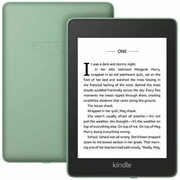


And whether the frontlight is on or off, the text on the Paperwhite’s screen is sharper and blacker if I didn’t know better I would think the KPW had the sharper screen. When the frontlights are off, the InkPad’s screen is slightly grayer, but whether the light is on or off the KPW still has a noticeable brown tint. In comparison to the KPW, the Inkpad’s frontlight much whiter and brighter. With an 8″ Pearl E-ink screen, the InkPad clearly won’t have as good of a screen as the latest premium ereaders, but the screen was still far better than I expected. In many ways the screen on my InkPad is nicer than the one on my T68 Lynx or my Paperwhite (2013). * (Kobo Aura HD, Bookeen Ocean, Onyx Boox T68 Lynx, Kindle DX, and the InkPad) Given its size you wouldn’t think this would be a one-handed ereader, but thanks to the lop-sided design it is the only one of the larger ereaders which I feel can be used that way (and since the text – but not the menus- can be reversed, the InkPad is equally good for righties and lefties). Of the five larger ereaders in my office at the moment*, the InkPad is easily the nicest to hold and use. You’ll find the headphone jack on the bottom right edge, and under a cap on the upper right edge are the microUSB port and the microSD card slot. It takes 6 or 7 swipes to go from off to maximum brightness, offering finely grained control of the screen brightness. That is the control for the frontlight, and it is one of the nicer features. The only obvious detail on the front of the InkPad are the page turn buttons and that strip, but if you look closely you’ll find a sensor strip above the screen. There’s also a strip of rubber above and below the buttons to help you grip the InkPad, and a corresponding rubber pad on the back. It has a brown plastic shell with page turn buttons to the right of the screen. The screen resolution is 1,600 x 1,200.īased on the design of the Color Lux, the 8″ color E-ink ereader which Pocketbook released last year, the InkPad has an unbalanced design which makes it ideal for one handed use. It sports an 8″ Pearl E-ink screen with frontlight and touchscreen. It has 4GB internal storage, a microSD card slot, Wifi, and a headphone jack. The InkPad runs Pocketbook’s proprietary OS on a 1GHz CPU with 512MB RAM. I am happier now than I was with the original firmware, but in either case I like the InkPad and continue to use it as my main ebook reader. This fixed the problem with the Epub bug, and it added more formatting options (as well as another Epub bug). About a month after posting the review I got the chance to downgrade my InkPad to the v4.x firmware. This review is based on a Pocketbook InkPad running the v5.4 firmware. They never actually got around to shipping it, and then stopped responding to my emails, forcing me to complain to Pocketbook corporate in order to get the parent company to ship my order. I bought my review unit from Pocketbook France in early September 2014.


 0 kommentar(er)
0 kommentar(er)
